KitchenAid KDRP462, YKDRP467, KDRP487, KDRP467, KDRP463 User Manual
...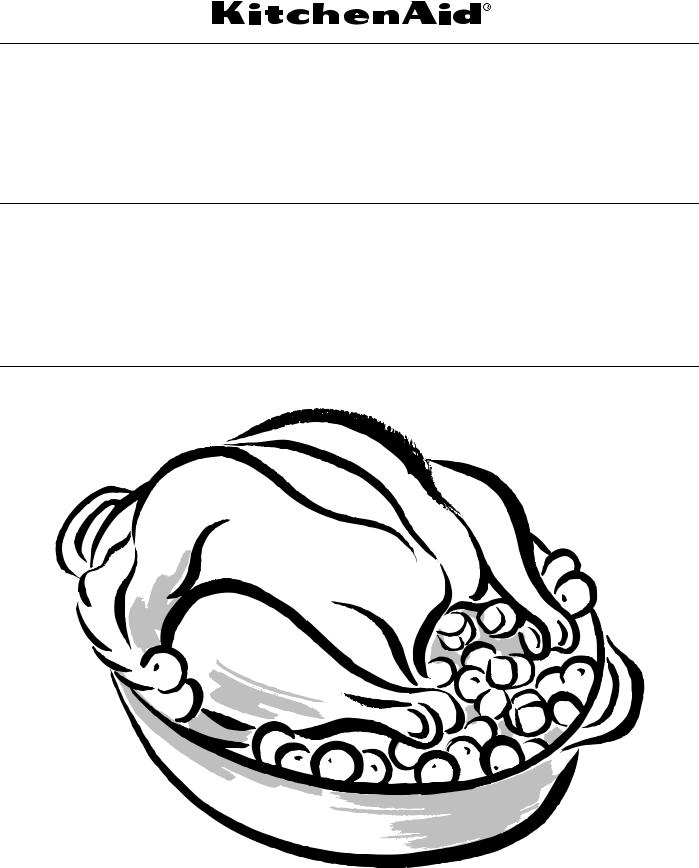
CLASSIC COMMERCIAL STYLE DUAL FUEL
CONVECTION RANGE
Use&CareGuide
For questions about features, operation/performance, parts, accessories or service, call: 1-800-422-1230 or visit our website at www.kitchenaid.com
In Canada call: 1-800-807-6777 or visit our website at www.KitchenAid.ca
CUISINIÈRE À CONVECTION - STYLE CLASSIQUE COMMERCIAL À BI-COMBUSTIBLE
Guided’utilisationetd’entretien
Au Canada composez le 1-800-807-6777 ou visitez notre site web à www.KitchenAid.ca
Table of Contents/Table des matières............................................................................. |
2 |
Models/Modèles KDRP407 KDRP462 KDRP463 KDRP467 KDRP487 YKDRP407 YKDRP467
W10086260B

TABLE OF CONTENTS |
|
RANGE SAFETY ............................................................................. |
3 |
The Anti-Tip Bracket .................................................................... |
4 |
PARTS AND FEATURES................................................................ |
6 |
COOKTOP USE ............................................................................ |
10 |
Cooktop Controls....................................................................... |
10 |
Sealed Surface Burners ............................................................. |
10 |
Simmer Plate.............................................................................. |
11 |
Grill (on some models) ............................................................. |
11 |
Griddle (on some models) ......................................................... |
13 |
Home Canning ........................................................................... |
14 |
Cookware ................................................................................... |
14 |
ELECTRONIC OVEN CONTROL ................................................. |
14 |
First Use/Power Interruption...................................................... |
14 |
Selector and Set Control Knobs ................................................ |
14 |
Enter and Cancel........................................................................ |
14 |
Clock .......................................................................................... |
14 |
OVEN USE..................................................................................... |
15 |
Aluminum Foil............................................................................. |
15 |
Positioning Racks and Bakeware .............................................. |
15 |
Bakeware.................................................................................... |
15 |
Meat Thermometer..................................................................... |
16 |
Oven Vent................................................................................... |
16 |
Bake ........................................................................................... |
16 |
Broil ............................................................................................ |
16 |
Convection Cooking................................................................... |
17 |
Convection Bake........................................................................ |
17 |
Convection Roast....................................................................... |
18 |
Convection Broil ........................................................................ |
19 |
Proofing Bread ........................................................................... |
19 |
Keep Warm................................................................................. |
19 |
Timed Cooking........................................................................... |
20 |
RANGE CARE ............................................................................... |
20 |
Self-Cleaning Cycle (on some models)...................................... |
20 |
General Cleaning........................................................................ |
21 |
Oven Lights ................................................................................ |
23 |
Oven Door .................................................................................. |
23 |
TROUBLESHOOTING .................................................................. |
23 |
ASSISTANCE OR SERVICE......................................................... |
25 |
In the U.S.A. ............................................................................... |
25 |
Accessories ................................................................................ |
25 |
In Canada ................................................................................... |
25 |
WARRANTY .................................................................................. |
26 |
TABLE DES MATIÈRES |
|
SÉCURITÉ DE LA CUISINIÈRE ................................................... |
27 |
La bride antibasculement........................................................... |
28 |
PIÈCES ET CARACTÉRISTIQUES .............................................. |
30 |
UTILISATION DE LA TABLE DE CUISSON................................ |
34 |
Commandes de la table de cuisson .......................................... |
34 |
Brûleurs de surface scellés ........................................................ |
35 |
Plaque de mijotage..................................................................... |
35 |
Gril (sur certains modèles).......................................................... |
36 |
Plaque à frire (sur certains modèles).......................................... |
37 |
Préparation de conserves à la maison....................................... |
38 |
Ustensiles de cuisson ................................................................ |
38 |
COMMANDE ÉLECTRONIQUE DU FOUR................................. |
39 |
Première utilisation/panne de courant....................................... |
39 |
Boutons de sélection et de commande de réglage................... |
39 |
Entrer et annuler ......................................................................... |
39 |
Horloge ....................................................................................... |
39 |
UTILISATION DU FOUR............................................................... |
39 |
Papier d’aluminium..................................................................... |
39 |
Positionnement des grilles et des ustensiles de cuisson .......... |
39 |
Ustensiles de cuisson ................................................................ |
40 |
Thermomètre à viande ............................................................... |
40 |
Évent du four .............................................................................. |
41 |
Cuisson au four .......................................................................... |
41 |
Cuisson au gril .......................................................................... |
41 |
Cuisson par convection ............................................................. |
42 |
Cuisson au four par convection ................................................. |
42 |
Rôtissage par convection .......................................................... |
43 |
Cuisson au gril par convection................................................... |
44 |
Levée du pain ............................................................................. |
44 |
Garder au chaud......................................................................... |
45 |
Cuisson minutée......................................................................... |
45 |
ENTRETIEN DE LA CUISINIÈRE................................................. |
46 |
Programme d'autonettoyage (sur certains modèles) ................ |
46 |
Nettoyage général ...................................................................... |
47 |
Lampes du four .......................................................................... |
48 |
Porte du four............................................................................... |
49 |
DÉPANNAGE................................................................................. |
49 |
ASSISTANCE OU SERVICE......................................................... |
51 |
GARANTIE..................................................................................... |
51 |
2
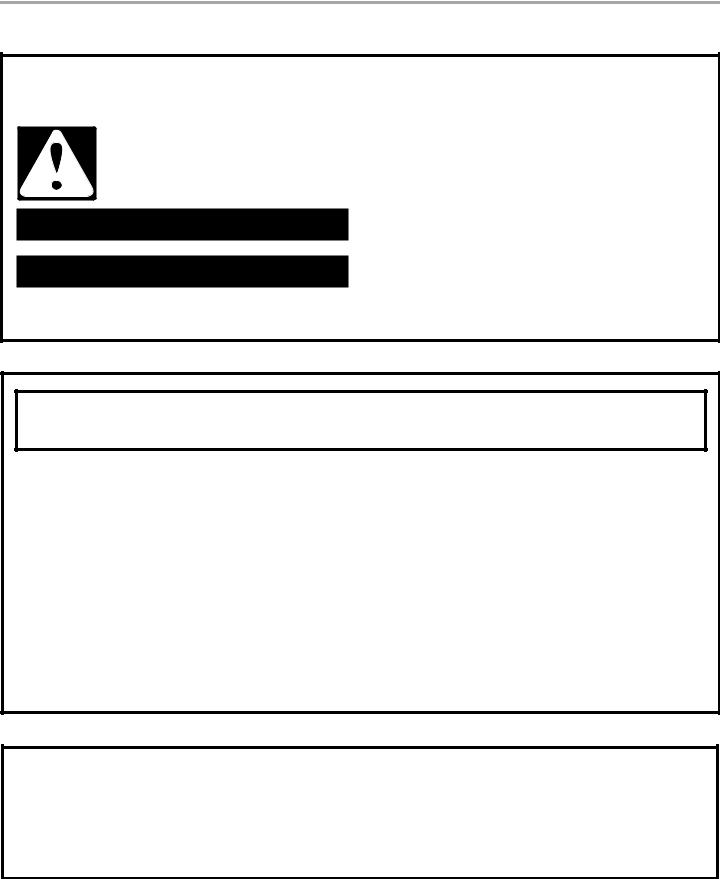
RANGE SAFETY
Your safety and the safety of others are very important.
We have provided many important safety messages in this manual and on your appliance. Always read and obey all safety messages.
This is the safety alert symbol.
This symbol alerts you to potential hazards that can kill or hurt you and others.
All safety messages will follow the safety alert symbol and either the word “DANGER” or “WARNING.” These words mean:
 DANGER
DANGER
 WARNING
WARNING
You can be killed or seriously injured if you don't immediately follow instructions.
You can be killed or seriously injured if you don't follow instructions.
All safety messages will tell you what the potential hazard is, tell you how to reduce the chance of injury, and tell you what can happen if the instructions are not followed.
WARNING: If the information in this manual is not followed exactly, a fire or explosion may result causing property damage, personal injury or death.
–Do not store or use gasoline or other flammable vapors and liquids in the vicinity of this or any other appliance.
–WHAT TO DO IF YOU SMELL GAS:
•Do not try to light any appliance.
•Do not touch any electrical switch.
•Do not use any phone in your building.
•Immediately call your gas supplier from a neighbor's phone. Follow the gas supplier's instructions.
•If you cannot reach your gas supplier, call the fire department.
–Installation and service must be performed by a qualified installer, service agency or the gas supplier.
The California Safe Drinking Water and Toxic Enforcement Act requires the Governor of California to publish a list of substances known to the State of California to cause cancer, birth defects, or other reproductive harm, and requires businesses to warn of potential exposure to such substances.
WARNING: This product contains a chemical known to the State of California to cause cancer, birth defects, or other reproductive harm.
This appliance can cause low-level exposure to some of the substances listed, including benzene, formaldehyde, carbon monoxide, toluene, and soot.
3
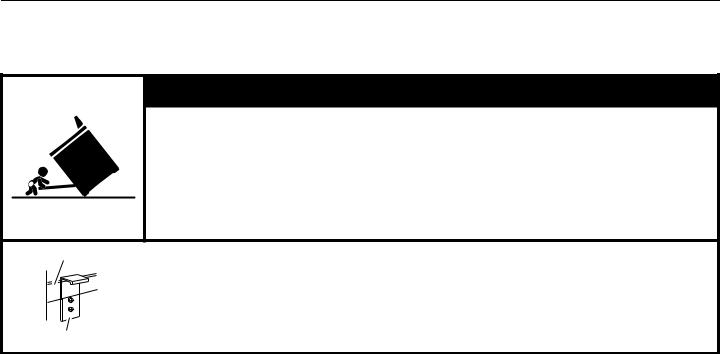
TheAnti-TipBracket
The range will not tip during normal use. However, the range can tip if you apply too much force or weight to the open door without the anti-tip bracket fastened down properly.
 WARNING
WARNING
Tip Over Hazard
A child or adult can tip the range and be killed.
Connect anti-tip bracket to wall behind range.
Reconnect the anti-tip bracket, if the range is moved.
See the installation instructions for details.
Failure to follow these instructions can result in death or serious burns to children and adults.
Rear Brace
Making sure the anti-tip bracket is installed:
• Slide range forward.
• Look for the anti-tip bracket securely attached to wall behind range.
• Slide range completely back, so anti-tip bracket is over rear brace of range.
Anti-Tip Bracket
4

IMPORTANT SAFETY INSTRUCTIONS
WARNING: To reduce the risk of fire, electrical shock, injury to persons, or damage when using the range, follow basic precautions, including the following:
■ WARNING: TO REDUCE THE RISK OF TIPPING OF THE RANGE, THE RANGE MUST BE SECURED BY PROPERLY INSTALLED ANTI-TIP DEVICES. TO CHECK IF THE DEVICES ARE INSTALLED PROPERLY, SLIDE RANGE COMPLETELY FORWARD, LOOK FOR ANTI-TIP BRACKET SECURELY ATTACHED TO THE WALL BEHIND THE RANGE AND SLIDE RANGE COMPLETELY BACK SO ANTI-TIP BRACKET IS OVER REAR BRACE OF RANGE.
■ WARNING: NEVER use this appliance as a space heater to heat or warm the room. Doing so may result in carbon monoxide poisoning and overheating of the oven.
■ WARNING: NEVER cover any slots, holes or passages in the oven bottom or cover an entire rack with materials such as aluminum foil. Doing so blocks air flow through the oven and may cause carbon monoxide poisoning. Aluminum foil linings may also trap heat, causing a fire hazard.
■ CAUTION: Do not store items of interest to children in cabinets above a range or on the backguard of a range – children climbing on the range to reach items could be seriously injured.
■Do Not Leave Children Alone – Children should not be left alone or unattended in area where the range is in use. They should never be allowed to sit or stand on any part of the range.
■Wear Proper Apparel – Loose-fitting or hanging garments should never be worn while using the range.
■User Servicing – Do not repair or replace any part of the range unless specifically recommended in the manual. All other servicing should be referred to a qualified technician.
■Storage in or on the Range – Flammable materials should not be stored in an oven or near surface units.
■Do Not Use Water on Grease Fires – Smother fire or flame or use dry chemical or foam-type extinguisher.
■Use Only Dry Potholders – Moist or damp potholders on hot surfaces may result in burns from steam. Do not let potholder touch hot heating elements. Do not use a towel or other bulky cloth.
■DO NOT TOUCH SURFACE UNITS OR AREAS NEAR UNITS
– Surface units may be hot even though they are dark in color. Areas near surface units may become hot enough to cause burns. During and after use, do not touch, or let clothing or other flammable materials contact surface units or areas near units until they have had sufficient time to cool. Among those areas are the cooktop and surfaces facing the cooktop.
■Never Leave Surface Units Unattended at High Heat Settings – Boilover causes smoking and greasy spillovers that may ignite.
■Glazed Cooking Utensils – Only certain types of glass, glass/ceramic, ceramic, earthenware, or other glazed utensils are suitable for range-top service without breaking due to the sudden change in temperature.
■Utensil Handles Should Be Turned Inward and Not Extend Over Adjacent Surface Units – To reduce the risk of burns, ignition of flammable materials, and spillage due to unintentional contact with the utensil, the handle of a utensil should be positioned so that it is turned inward, and does not extend over adjacent surface units.
■Clean Cooktop With Caution – If a wet sponge or cloth is used to wipe spills on a hot cooking area, be careful to avoid steam burn. Some cleaners can produce noxious fumes if applied to a hot surface.
■Use Care When Opening Door – Let hot air or steam escape before removing or replacing food.
■Do Not Heat Unopened Food Containers – Build-up of pressure may cause container to burst and result in injury.
■Keep Oven Vent Ducts Unobstructed.
■Placement of Oven Racks – Always place oven racks in desired location while oven is cool. If rack must be moved while oven is hot, do not let potholder contact hot heating element in oven.
■DO NOT TOUCH HEATING ELEMENTS OR INTERIOR SURFACES OF OVEN – Heating elements may be hot even though they are dark in color. Interior surfaces of an oven become hot enough to cause burns. During and after use, do not touch, or let clothing or other flammable materials contact heating elements or interior surfaces of oven until they have had sufficient time to cool. Other surfaces of the appliance may become hot enough to cause burns – among these surfaces are oven vent openings and surfaces near these openings, oven doors, and windows of oven doors.
■Proper Installation – The range, when installed, must be electrically grounded in accordance with local codes or, in the absence of local codes, with the National Electrical Code, ANSI/NFPA 70. In Canada, the range must be electrically grounded in accordance with Canadian Electrical Code. Be sure the range is properly installed and grounded by a qualified technician.
■Disconnect the electrical supply before servicing the appliance.
■Injuries may result from the misuse of appliance doors or drawers such as stepping, leaning, or sitting on the doors or drawers.
■Maintenance – Keep range area clear and free from combustible materials, gasoline, and other flammable vapors and liquids.
■Top burner flame size should be adjusted so it does not extend beyond the edge of the cooking utensil.
For self-cleaning ranges –
■Do Not Clean Door Gasket – The door gasket is essential for a good seal. Care should be taken not to rub, damage, or move the gasket.
■Do Not Use Oven Cleaners – No commercial oven cleaner or oven liner protective coating of any kind should be used in or around any part of the oven.
■Clean Only Parts Listed in Manual.
■Before Self-Cleaning the Oven – Remove broiler pan and other utensils. Wipe off all excessive spillage before initiating the cleaning cycle.
For units with ventilating hood –
■Clean Ventilating Hoods Frequently – Grease should not be allowed to accumulate on hood or filter.
■When flambéing foods under the hood, turn the fan on.
SAVE THESE INSTRUCTIONS
5

PARTS AND FEATURES
This manual covers several different models. The range you have purchased may have some or all of the items listed. The locations and appearances of the features shown here may not match those of your model.
48" (122 cm) Control Panel
A |
B |
C |
D E F G H |
I |
J |
K |
L |
M N O P Q |
R |
S |
Cooktop |
|
|
Oven |
|
Cooktop |
|
Oven |
|
Cooktop |
|
A.Surface burner locator
B.Left rear control knob (15,000 Btu/h)
C.Left front control knob (6,000 Btu/h)
D.Selector knob E. Enter button
F. Oven light switch
G.Cancel button
H.Set knob
I.Center rear left control knob (15,000 Btu/h)
J.Center front left control knob (15,000 Btu/h)
KCenter rear right control knob (15,000 Btu/h)
L.Center front right control knob (15,000 Btu/h)
M.Selector knob
N.Enter button
O.Oven light switch P. Cancel button
Q.Set knob
R.Right rear control knob (15,000 Btu/h)
S.Right front control knob (15,000 Btu/h)
36" (91.44 cm) Control Panels
A B |
C |
D |
E F G |
H |
I |
J |
K |
L |
Cooktop |
|
|
Oven |
|
|
Cooktop |
|
|
A. Surface burner locator |
|
E. Selector knob |
|
|
J. Front center control knob (15,000 Btu/h) |
|||
B. Left rear control knob (15,000 Btu/h) |
F. Enter button |
|
|
K. Right rear control knob (15,000 Btu/h) |
||||
C. Left front control knob (6,000 Btu/h) |
G. Oven light switch |
|
L. Right front control knob (6,000 Btu/h)) |
|||||
D. Rear center control knob (15,000 Btu/h) |
H. Cancel button |
|
|
|
|
|||
|
|
|
I. Set knob |
|
|
|
|
|
6
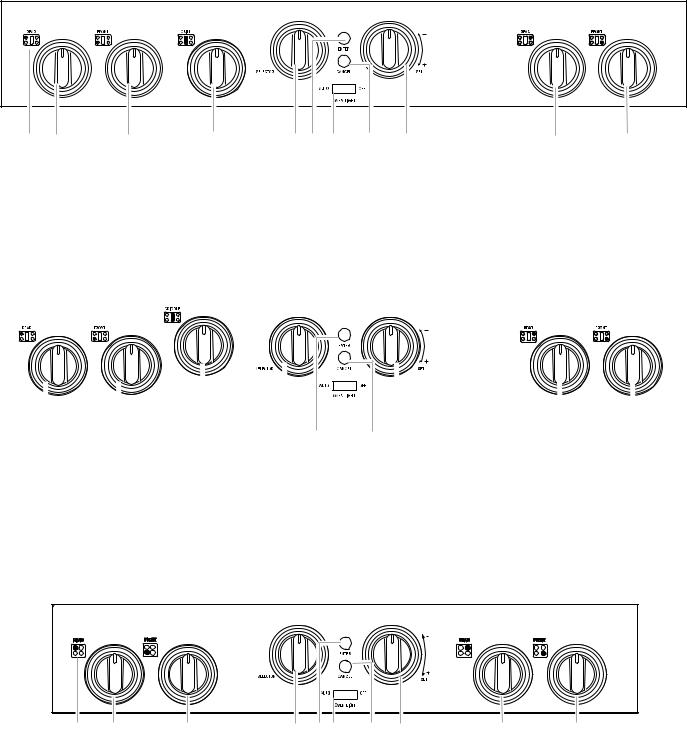
|
A B |
C |
D |
E F G |
H |
I |
J |
K |
|||
|
|
Cooktop |
|
|
Oven |
|
|
Cooktop |
|
|
|
|
|
A. Surface burner locator |
|
E. Selector knob |
|
J. Right rear control knob (15,000 Btu/h) |
|||||
|
|
B. Left rear control knob (15,000 Btu/h) |
F. Enter button |
|
K. Right front control knob (6,000 Btu/h) |
||||||
|
|
C Left front control knob (6,000 Btu/h) |
G. Oven light switch |
|
|
|
|
||||
|
|
D. Griddle control knob (18,000 Btu/h) |
H. Cancel button |
|
|
|
|
||||
|
|
|
|
|
I. Set knob |
|
|
|
|
|
|
|
|
|
|
|
|
|
|
|
|
|
|
|
|
|
|
|
|
|
|
|
|
|
|
|
|
|
|
|
|
|
|
|
|
|
|
|
|
|
|
|
|
|
|
|
|
|
|
|
|
|
|
|
|
|
|
|
|
|
|
|
|
|
|
|
|
|
|
|
|
|
|
|
|
|
|
|
|
|
|
|
|
|
|
A B |
C |
D |
E |
F G |
H I |
J |
K |
|
Cooktop |
|
|
Oven |
|
Cooktop |
|
|
A. Surface burner locator |
|
|
E. Selector knob |
J. Right rear control knob (15,000 Btu/h) |
||
|
B. Left rear control knob (15,000 Btu/h) |
|
F. Enter button |
K. Right front control knob (6,000 Btu/h) |
|||
|
C Left front control knob (6,000 Btu/h) |
|
G. Oven light switch |
|
|
||
|
D. Griddle control knob (15,000 Btu/h) |
|
H. Cancel button |
|
|
||
|
|
|
|
I. Set knob |
|
|
|
30" (76.2 cm) Control Panel
A |
B |
C |
D |
E F |
G |
H |
I |
J |
Cooktop |
|
|
Oven |
|
|
Cooktop |
|
|
A. Surface burner locator |
D. Selector knob |
I. Right rear control knob (15,000 Btu/h) |
B. Left rear control knob (15,000 Btu/h) |
E. Enter button |
J. Right front control knob (15,000 Btu/h) |
C Left front control knob (15,000 Btu/h) |
F. Oven light switch |
|
G.Cancel button
H.Set knob
7
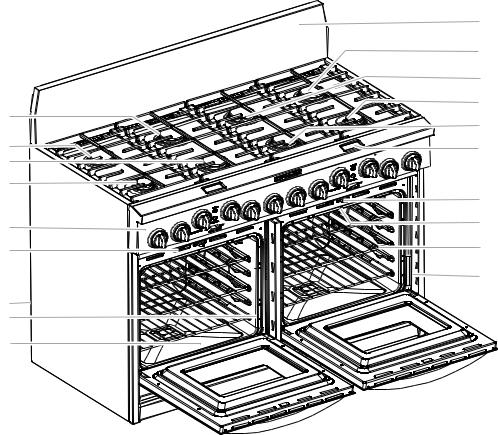
Range
|
J |
|
|
K |
|
|
L |
|
A |
M |
|
N |
||
|
||
B |
O |
|
C |
||
|
||
D |
|
|
|
P |
|
E |
Q |
|
|
||
F |
R |
|
|
S |
G
H
I
A.Center rear left surface burner
B.Left rear surface burner
C.Center front left surface burner
D.Left front surface burner
E.Control panel
F. Oven vent
G.Gas regulator
(located in rear of range)
H.Door gasket
I.Bake element (not visible)
J.Pin connector
(located in rear of range, for factory testing only)
K.Right rear surface burner
L.Center rear right surface burner
M.Right front surface burner
N.Center front right surface burner
O.Electronic oven control display
P. Self-cleaning latch
Q.Broil element (not shown)
R.Oven rack
S.Model and serial number (located on the right-hand side oven trim)
8
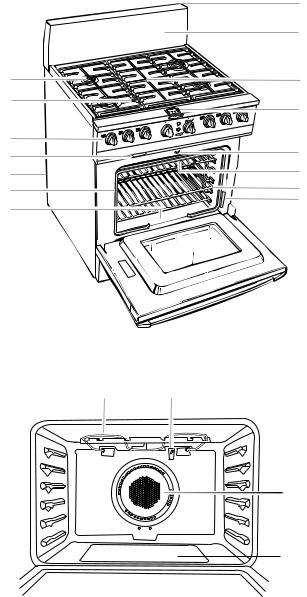
Range
|
H |
|
I |
A |
J |
|
|
B |
K |
|
|
C |
|
D |
L |
E |
M |
F |
N |
G |
O |
|
Oven Interior
A B
C
 D
D
A.Surface burner
B.Surface burner grate
C.Control panel
D.Oven vent
E.Gas regulator (rear of range) F. Door gasket
G.Bake element (not visible)
H.2-pin connector (not shown; rear of range -not for consumer use - for factory test only)
I.Stainless steel backguard (island trim not shown)
J.Grill, griddle, center burners or filler grate
K.Electronic oven control display
L.Self-cleaning latch
M.Broil element (not shown)
N.Oven rack
O.Model and serial number plate (located on the right-hand side oven trim)
A.Broil element
B.Oven cavity sensor
C.Convection fan and ring element (not visible)
D.Bake element (not visible)
9
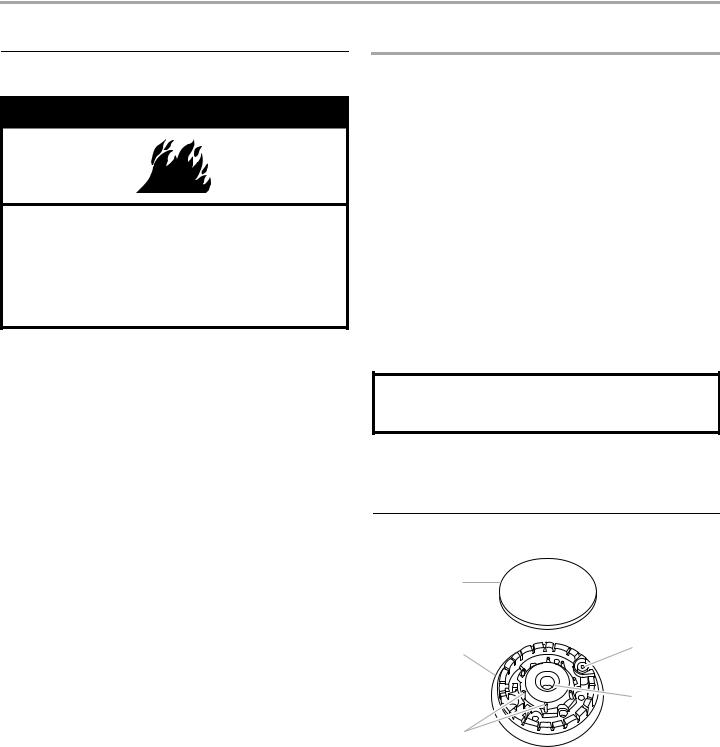
COOKTOP USE
CooktopControls
 WARNING
WARNING
Fire Hazard
Do not let the burner flame extend beyond the edge of the pan.
Turn off all controls when not cooking.
Failure to follow these instructions can result in death or fire.
IMPORTANT: Your cooktop is factory-set for use with Natural Gas. If you wish to use LP Gas, an LP Gas Conversion Kit is included with your new range. See the instructions included with the LP Gas conversion kit for details on making this conversion.
Electric igniters automatically light the surface burners when control knobs are turned to LITE.
The large burners (15,000 Btu/h) provide the highest heat setting, and are ideal for cooking large quantities of food or liquid, using large pots and pans. The small burners (6,000 Btu/h) allow more accurate simmer control at the lowest setting, and are ideal for cooking smaller quantities of food, using smaller pots and pans.
Before setting a control knob, place filled cookware on the grate. Do not operate a burner using empty cookware or without any cookware on the grate.
NOTE: Visually check that the burner has lit. If the burner does not ignite, listen for the clicking sound. If you do not hear the igniter click, turn off the burner. Check for a tripped circuit breaker or blown fuse.
Check that the control knob is pressed completely down on the valve shaft. If the spark igniter still does not operate, call a trained repair specialist.
Proper grounding and polarity are necessary for correct operation of the electric ignition system. If the wall receptacle does not provide correct polarity, the igniter will become grounded and occasionally click, even after the burner has ignited. Contact a trained repair specialist to check the wall receptacle to see whether it is wired with the correct polarity.
To Set:
1.Push in and turn knob counterclockwise to LITE.
All surface burners will click. Only the burner with the control knob turned to LITE will produce a flame.
2.Turn knob to anywhere between HI and LO. Use the following chart as a guide when setting heat levels.
SETTING |
RECOMMENDED USE |
|
|
|
|
LITE |
■ |
Light the burner. |
|
|
|
HI |
■ |
Start food cooking. |
|
■ Bring liquid to a boil. |
|
|
|
|
MED to HI |
■ |
Hold a rapid boil. |
|
■ Quickly brown or sear food. |
|
|
|
|
MED |
■ |
Fry or sauté foods. |
|
■ Hold a slow boil. |
|
|
|
|
MED to LO |
■ |
Cook soups, sauces and gravies. |
|
■ Stew or steam foods. |
|
|
|
|
LO |
■ |
Keep food warm. |
(with Simmer Plate) |
■ |
Melt chocolate or butter. |
|
||
|
■ |
Simmer. |
|
|
|
REMEMBER: When range is in use or (on some models) during the Self-Cleaning cycle, the entire cooktop area may become hot.
Power Failure
In case of prolonged power failure, the surface burners can be lit manually. Hold a lit match near a burner and turn knob counterclockwise to HI. After burner lights, turn knob to setting.
SealedSurfaceBurners
A
B |
D |
|
|
|
E |
C |
|
A.Burner cap
B.Burner base
C.Alignment pins
D.Igniter
E.Gas tube opening
10
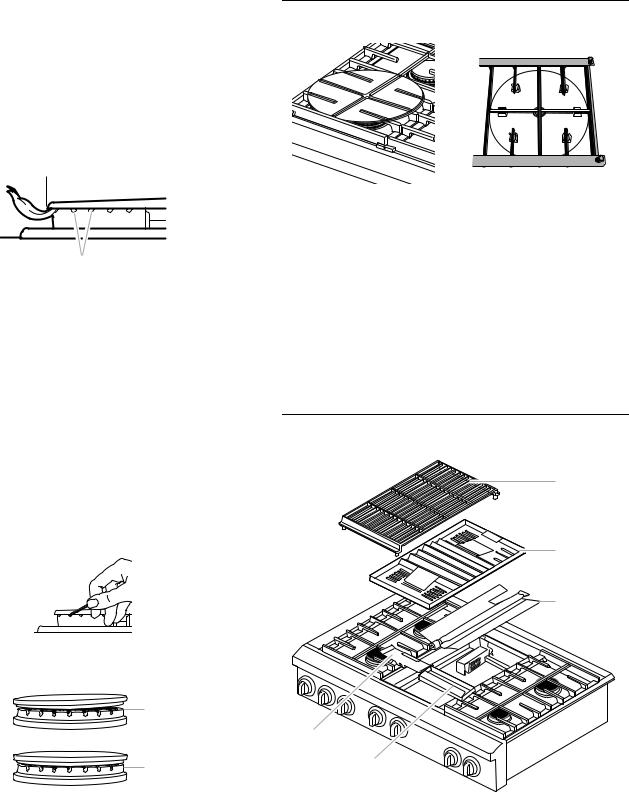
IMPORTANT: Do not obstruct the flow of combustion and ventilation air around the burner grate edges.
Burner cap: Always keep the burner cap in place when using a surface burner. A clean burner cap will help avoid poor ignition and uneven flames. Always clean the burner cap after a spillover and routinely remove and clean the caps according to the “General Cleaning” section.
Gas tube opening: Gas must flow freely throughout the gas tube opening for the burner to light properly. Keep this area free of soil and do not allow spills, food, cleaning agents or any other material to enter the gas tube opening. Protect it from spillovers by always using a burner cap.
 A
A
B
A.1-1¹⁄" (25-38 mm)
B.Burner ports
Burner ports: Check burner flames occasionally for proper size and shape as shown above. A good flame is blue in color, not yellow. Keep this area free of soil and do not allow spills, food, cleaning agents or any other material to enter the burner ports.
To Clean:
IMPORTANT: Before cleaning, make sure all controls are off and the oven and cooktop are cool. Do not use oven cleaners, bleach or rust removers.
1.Remove the burner cap from the burner base and clean according to “General Cleaning” section.
2.Clean the gas tube opening with a damp cloth.
3.Clean clogged burner ports with a straight pin as shown. Do not enlarge or distort the port. Do not use a wooden toothpick. If the burner needs to be adjusted, contact a trained repair specialist.
4.Replace the burner cap, making sure the alignment pins are properly aligned with the burner cap.
A
B
A.Incorrect
B.Correct
5.Turn on the burner. If the burner does not light, check cap alignment. If the burner still does not light, do not service the sealed burner yourself. Contact a trained repair specialist.
SimmerPlate
■The Simmer Plate is made of aluminum with a nonstick coating to evenly spread the heat over the bottom of cookware.
■Channels on the bottom of the Simmer Plate have been designed so it fits properly and securely over the grate. See above illustration.
■The Simmer Plate may be used on large and small surface burners.
■Use the Simmer Plate with burner settings in the medium to low range on the cooktop when lower temperatures are needed for simmering, or for maintaining food at a low temperature over an extended period of time.
See “Assistance or Service” section to order extra Simmer Plates.
Grill(onsomemodels)
A
B
 C
C
D
E
F
A. Grill grate |
D. Burner assembly |
B. Wave tray |
E. Front spill guard |
C. Wave plate |
F. Drip tray |
The grill module consists of a cast-iron grate, a wave tray, a wave plate, a burner assembly, a front spill guard and a drip tray. It is used to grill foods. Refer to the “Grill Chart” for cook times and settings.
When using the grill, follow the guidelines below.
■Do not leave the grill unattended while cooking.
11
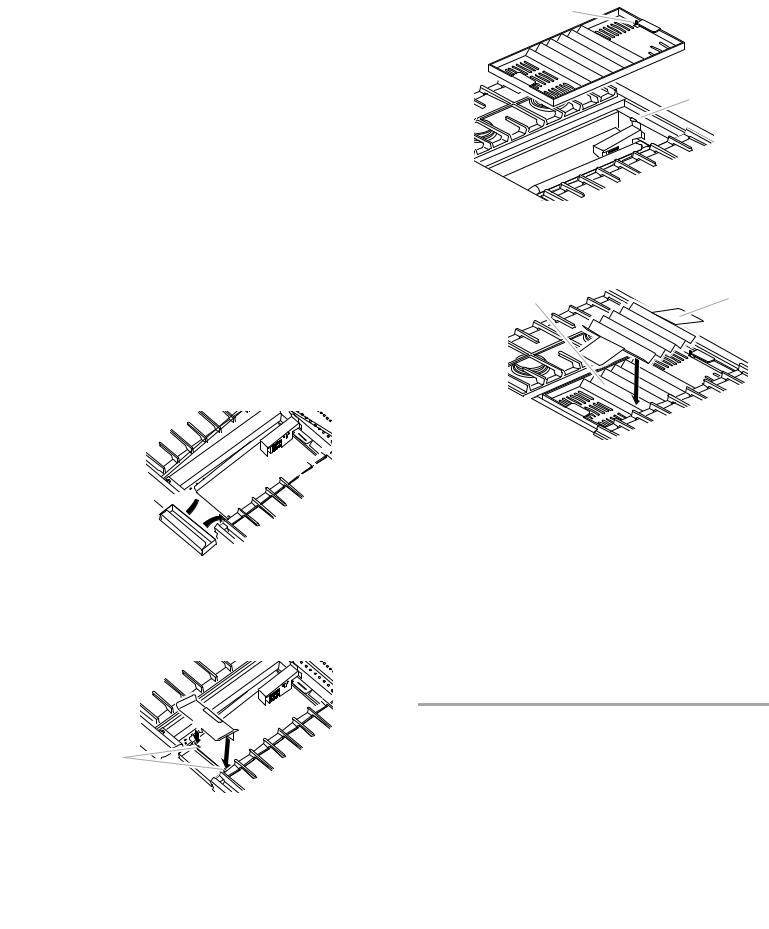
■Do not use aluminum foil, charcoal or wood chips.
■Trim excess fat to reduce spattering. Slit the remaining fat on the edges to avoid curling.
■Allow space between food on the grill. Crowding food will result in uneven cooking.
■Use a metal spatula or tongs to turn food.
■Steaks, chops and hamburgers should be turned only once to avoid loss of juices.
■For even cooking, foods such as chicken quarters should be turned several times.
■To check for doneness of meats and poultry, use an instant read thermometer or make a small cut in the center of the food. This will avoid loss of juices.
Before removing or replacing grill, make sure the control knobs are turned to OFF. Allow the grill to cool completely before handling.
To Remove:
1.Remove grill grate.
2.Remove wave tray and wave plate.
3.Remove burner assembly.
4.Remove front spill guard.
5.Remove drip tray.
6.Clean basin. See “General Cleaning” section.
To Replace:
1.Lift burner assembly out of basin and set aside.
2.Place drip tray on bottom of grill basin and slide the tray forward so that it is located side to side and against the locating feet of the rear spill guard.
A 

B 

C 
A.Rear spill guard
B.Locating feet
C.Drip tray
3.Insert the front spill guard feet into the slots in the rear spill guard. The rear flange will rest on the burner box.
A
B
A.Front spill guard
B.Feet and slots
4.Place burner assembly over spill guard, making sure burner’s rear flange is seated in slot.
5.Install the wave tray into the grill. The tab in the left rear corner of the bay must fit through the slot in the left rear corner of the wave tray.
A
B
A.Slot for locating tab
B.Locating tab
6.Place the wave plate on the wave tray. The wave plate must be centered on the wave tray.
A B
A.Wave tray
B.Wave plate
7. Replace grill grate.
To Use:
1.Turn on overhead range hood.
2.If desired, apply a light coating of vegetable oil or nonstick cooking spray to grill grate.
3.Push in and turn knob to LITE/HI. The flame will ignite in 30-40 seconds. Allow grill to preheat for 10 minutes.
4.Turn knob to desired cook setting. Place food on grill.
GRILL CHART
The settings and times are guidelines only and may need to be adjusted for individual tastes.
FOOD |
SETTING |
COOK TIME |
|
|
TOTAL MINUTES |
|
|
|
Steak |
|
|
1" (2.5 cm) |
|
|
medium |
MED-HI |
16-20 |
well-done |
MED-HI |
20-30 |
|
|
|
Ground Meat Patties |
|
|
¹⁄ - ³⁄ " (1.3-1.9 cm) |
MED |
20-25 |
12
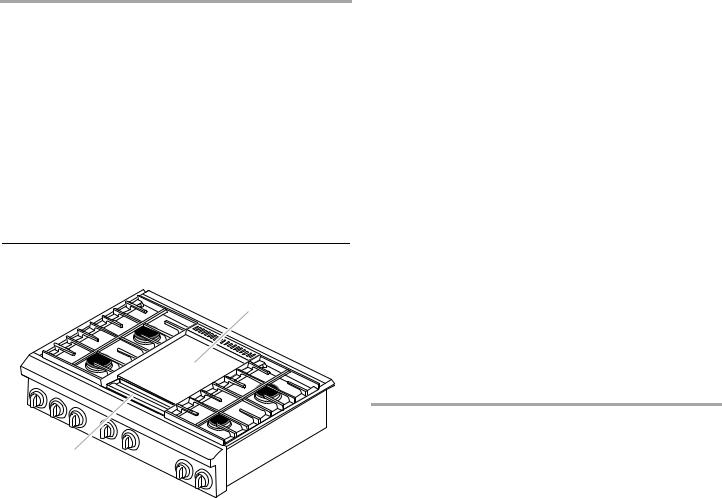
FOOD |
SETTING |
COOK TIME |
|
|
TOTAL MINUTES |
|
|
|
Pork Chops |
|
|
1" (2.5 cm) |
MED |
35-55 |
|
|
|
Ham Slices |
|
|
¹" (1.3 cm) |
MED-HI |
8-12 |
|
|
|
Frankfurters and |
MED |
8-15 |
Precooked Sausages |
|
|
|
|
|
Chicken |
|
|
Quarters |
MED-LO |
50-80 |
Breasts, boneless |
MED |
20-40 |
|
|
|
Fish Steaks |
|
|
³⁄ - 1" (1.9-2.5 cm) |
MED |
10-15 |
|
Griddle(onsomemodels)
A
B
A.Griddle
B.Drip tray
The griddle, made of brushed, cold-rolled steel, is similar to those used in commercial kitchens. The griddle is packaged with a protective grease coating covered with paper that must be removed completely with hot, soapy water. Rinse, dry, and season the griddle immediately after removing the protective coating or the griddle will rust. See the “General Cleaning” section for more information.
■It is normal for the griddle to darken with use.
■Do not place any pots or pans on the seasoned griddle to keep food warm.
■The griddle must be level to operate properly.
■Do not pour cold water on a hot griddle. This may warp the griddle, producing an uneven cooking surface.
To Season or Reseason the Griddle:
Seasoning the griddle is important because it keeps food from sticking during cooking and averts rusting.
1.Pour 1 tsp (5 mL) of vegetable oil onto the center of the griddle and spread evenly over the entire surface with a paper towel. Do not use corn or olive oil.
2.Push in and turn knob to 350°F (177°C) setting. When the oil begins to smoke, turn the control knob to the OFF position and allow the griddle to cool. Wipe off excess oil with a paper towel.
3.Apply a thin layer of vegetable oil to the entire surface of the griddle. The griddle is now ready to use.
4.After each use, reseason the griddle using steps 1 through 3.
5.The griddle can be used without additional vegetable oil after it has been properly seasoned.
Using the Griddle:
1.Position the drip tray under the front edge of the griddle to catch grease and food residue.
2.Push in and turn the control knob to desired temperature.
3.Allow 10 to 15 minutes for the griddle to preheat to the temperature selected.
4.Place food on the griddle and cook to desired doneness.
After Each Use:
1.Turn the griddle off and let cool. Rinse griddle with ½ cup (125 mL) hot, soapy water.
2.Scrape griddle residue into drip tray.
3.Remove and clean the drip tray and the area below. Use care when tipping the drip tray so that the contents are not spilled when removing.
4.Rinse griddle with ½ cup (125 mL) hot water. Dry griddle and drip tray with paper towel to remove excess grease and oil.
GRIDDLE CHART
The settings and times are guidelines only and may need to be adjusted for individual tastes.
FOOD |
SETTING |
COOK TIME |
|
|
TOTAL MINUTES |
|
|
|
Sausage Patties |
325°F (163°C) |
12-18 |
and Links |
|
|
|
|
|
Bacon Slices |
350°F (177°C) |
7-11 |
|
|
|
Ham Steak |
325°F (163°C) |
5-7 |
(fully cooked) |
|
|
|
|
|
Ground Meat |
350°F (177°C) |
10-15 |
Patties |
|
|
|
|
|
Frankfurters and |
325°F (163°C) |
8-15 |
Precooked |
|
|
Sausages |
|
|
|
|
|
Fish Steaks, Fillets |
325°F (163°C) |
8-15 |
|
|
|
Eggs |
300°F (149°C) |
3-5 |
|
|
|
Hash Brown |
400°F to 425°F |
8-12 |
Potatoes |
(204°C to 218°C) |
|
|
|
|
French Toast |
350°F (177°C) |
5-7 |
|
|
|
Pancakes |
350°F (177°C) |
2-4 |
|
|
|
Grilled |
325°F (163°C) |
3-5 |
Sandwiches |
|
|
|
|
|
13
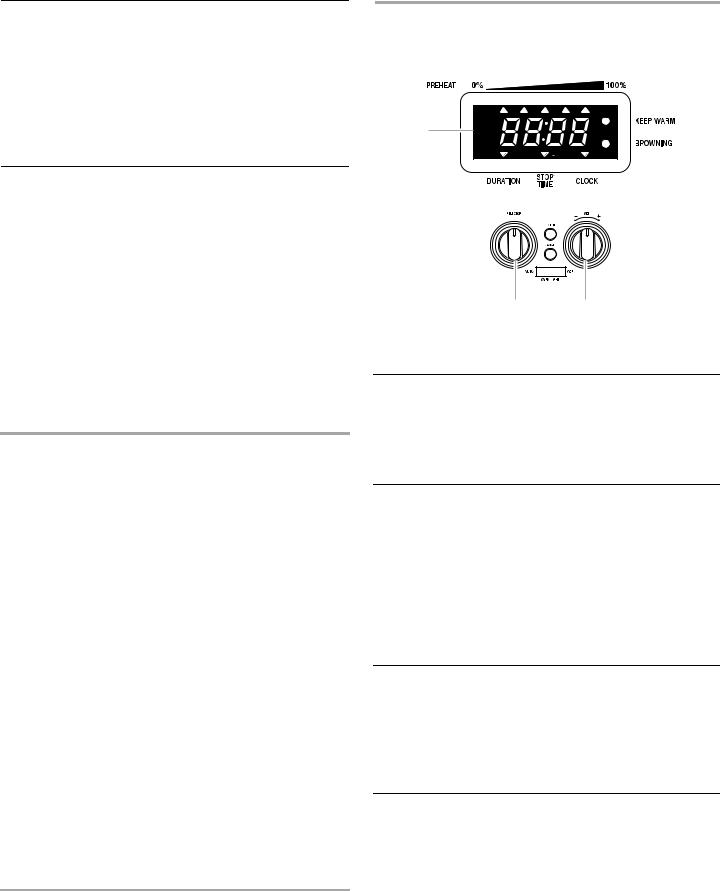
HomeCanning
When canning for long periods, alternate the use of surface burners between batches. This allows time for the most recently used areas to cool.
■Center the canner on the grate.
■Do not place canner on 2 surface burners at the same time.
■For more information, contact your local agricultural department. Companies that manufacture home canning products can also offer assistance.
ELECTRONIC OVEN
CONTROL
A
Cookware
IMPORTANT: Do not leave empty cookware on a hot surface cooking area, element or surface burner.
Ideal cookware should have a flat bottom, straight sides, and a well-fitting lid and the material should be of medium-to-heavy thickness.
Rough finishes may scratch the cooktop. Aluminum and copper may be used as a core or base in cookware. However, when used as a base they can leave permanent marks on the cooktop or grates.
Cookware material is a factor in how quickly and evenly heat is transferred, which affects cooking results. A nonstick finish has the same characteristics as its base material. For example, aluminum cookware with a nonstick finish will take on the properties of aluminum.
Use the following chart as a guide for cookware material characteristics.
COOKWARE |
CHARACTERISTICS |
|
|
|
|
Aluminum |
■ Heats quickly and evenly. |
|
|
■ Suitable for all types of cooking. |
|
|
■ Medium or heavy thickness is best for |
|
|
|
most cooking tasks. |
|
|
|
Cast iron |
■ Heats slowly and evenly. |
|
|
■ Good for browning and frying. |
|
|
■ Maintains heat for slow cooking. |
|
|
|
|
Ceramic or |
■ |
Follow manufacturer’s instructions. |
Ceramic glass |
■ Heats slowly, but unevenly. |
|
|
||
|
■ Ideal results on low to medium heat |
|
|
|
settings. |
|
|
|
Copper |
■ Heats very quickly and evenly. |
|
|
|
|
Earthenware |
■ |
Follow manufacturer’s instructions. |
|
■ Use on low heat settings. |
|
|
|
|
Porcelain |
■ See stainless steel or cast iron. |
|
enamel-on- |
|
|
steel or cast |
|
|
iron |
|
|
|
|
|
Stainless steel |
■ Heats quickly, but unevenly. |
|
|
■ A core or base of aluminum or copper |
|
on stainless steel provides even heating.
BC
A.Display
B.Selector control knob
C.Set control knob
FirstUse/PowerInterruption
When power is first supplied to the appliance, “PF” will appear.
If “PF” appears at any other time, a power failure has occurred. Turn the SELECTOR control knob to the RESET position, press the ENTER button, and follow the clock setting instructions in the “Clock” section.
SelectorandSetControlKnobs
All cooking functions are set with the SELECTOR control knob. The selected function will automatically begin with current settings after 10 seconds if other settings are not changed. Once a cycle is complete, turn the SELECTOR control knob to the RESET position to select a new function.
All temperature or time adjustments are set with the SET control knob. All temperature adjustments are displayed in 5°F (3°C) increments.
The speed with which the knob is turned is reflected on the display.
EnterandCancel
The ENTER button begins any oven function.
The CANCEL button stops any oven function except for the Clock/Time of Day. After canceling an operation, “End” will be displayed to show the function was canceled.
The cooling fan might continue operating after a function has ended, but will shut off automatically when the oven has cooled.
Clock
This is a 12-hour clock and does not show a.m. or p.m.
To Set:
1.Turn the SELECTOR knob to the RESET position.
2.Press the ENTER button until the display shows “12:00” and the CLOCK indicator is blinking.
3.Turn the SET knob to set the time of day.
4.Press the ENTER button to accept time on display.
To Change: Repeat steps 2-4 to change time of day to the display.
14
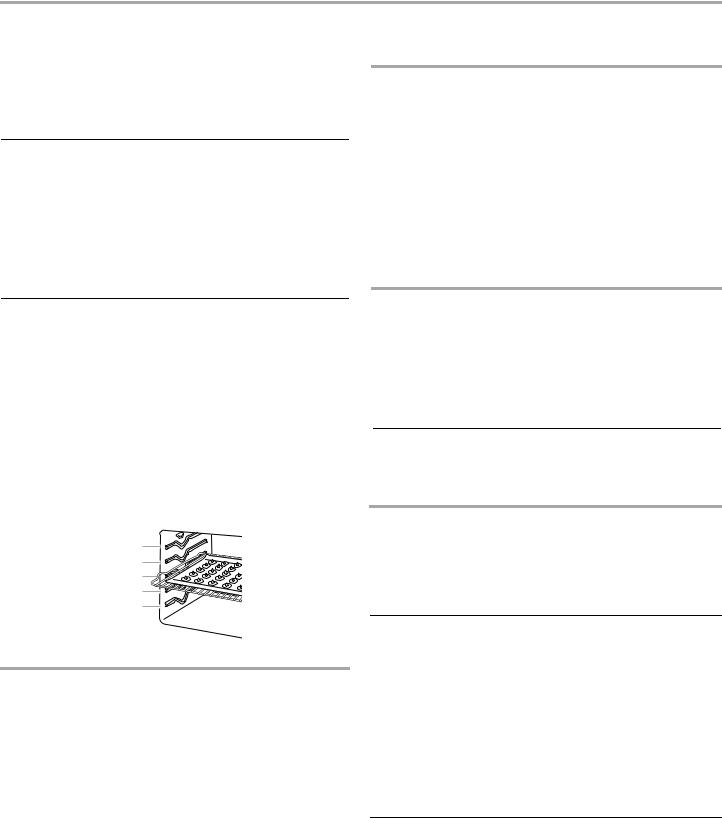
OVEN USE
Odors and smoke are normal when the oven is used the first few times, or when it is heavily soiled.
IMPORTANT: The health of some birds is extremely sensitive to the fumes given off. Exposure to the fumes may result in death to certain birds. Always move birds to another closed and wellventilated room.
AluminumFoil
IMPORTANT: To avoid permanent damage to the oven bottom finish, do not line the oven bottom with any type of foil, liners or cookware.
■Do not cover entire rack with foil because air must be able to move freely for best cooking results.
■To catch spills, place foil on rack below dish. Make sure foil is at least ½" (1.3 cm) larger than the dish and that it is turned up at the edges.
PositioningRacksandBakeware
IMPORTANT: To avoid permanent damage to the porcelain finish, do not place food or bakeware directly on the oven door or bottom.
RACKS
NOTES:
■Position racks before turning on the oven.
■Do not position racks with bakeware on them.
■Make sure racks are level.
To move a rack, pull it out to the stop position, raise the front edge, then lift out. Use the following illustration and charts as a guide.
5
4
3
2
1
Traditional Cooking
FOOD |
RACK POSITION* |
Large roasts, turkeys, angel food, |
1 or 2 |
bundt cakes, quick breads, pies |
|
|
|
Yeast breads, casseroles, meat and |
2 |
poultry |
|
|
|
Cookies, biscuits, muffins, cakes |
2 or 3 |
|
|
*On models with the CleanBake™ feature, foods may be placed on a lower rack position.
Convection Cooking
OVEN SETTING |
NUMBER OF |
RACK |
|
RACKS USED |
POSITION(S) |
|
|
|
Convection Bake |
1 |
1, 2 or 3 |
|
|
|
Convection Bake |
2 |
2 and 4 |
|
|
|
Convection Bake |
3 |
1, 3 and 5 |
|
|
|
Convection Roast |
1 |
1, 2 or 3 |
|
|
|
Convection Broil |
1 |
3 or 4 |
|
|
|
BAKEWARE
To cook food evenly, hot air must be able to circulate. Allow 1" (2.5 cm) of space around bakeware and oven walls. Use the following chart as a guide.
NUMBER |
POSITION ON RACK |
OF PAN(S) |
|
|
|
1 |
Center of rack. |
|
|
2 |
Side by side or slightly staggered. |
|
|
3 or 4 |
Opposite corners on each rack. Make sure |
|
that no bakeware piece is directly over |
|
another. |
Bakeware
The bakeware material affects cooking results. Follow manufacturer’s recommendations and use the bakeware size recommended in the recipe. Use the following chart as a guide.
BAKEWARE/ |
RECOMMENDATIONS |
RESULTS |
|
|
|
Light colored |
■ Use temperature and time |
aluminum |
recommended in recipe. |
■Light golden crusts
■Even browning
Dark aluminum and |
■ |
May need to reduce baking |
|
other bakeware with |
|
temperatures 25°F (15°C). |
|
dark, dull and/or |
■ |
Use suggested baking time. |
|
nonstick finish |
|||
■ For pies, breads and casseroles, |
|||
■ Brown, crisp |
|||
|
use temperature recommended in |
||
crusts |
|
||
|
recipe. |
||
|
|
||
|
■ Place rack in center of oven. |
||
|
|
|
|
Insulated cookie |
■ |
Place in the bottom third of oven. |
|
sheets or baking |
■ |
May need to increase baking time. |
|
pans |
|||
|
|
||
■Little or no bottom browning
Stainless steel |
■ May need to increase baking time. |
■Light, golden crusts
■Uneven browning
15
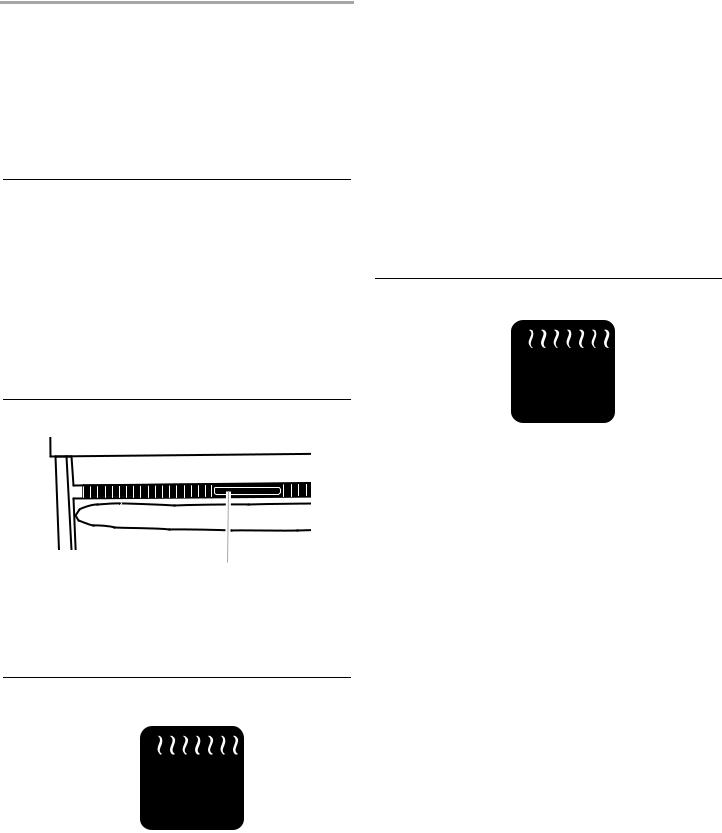
BAKEWARE/ |
RECOMMENDATIONS |
|
RESULTS |
|
|
|
|
|
Stoneware/Baking |
■ Follow manufacturer’s instructions. |
|
stone |
|
|
■ |
Crisp crusts |
|
|
|
|
Ovenproof |
■ May need to reduce baking |
|
glassware, ceramic |
temperatures 25°F (15°C). |
|
glass or ceramic |
|
|
■ |
Brown, crisp |
|
|
crusts |
|
MeatThermometer
On models without a temperature probe, use a meat thermometer to determine doneness of meat, poultry and fish. The internal temperature, not appearance, should be used to determine doneness. A meat thermometer is not supplied with this appliance.
■Insert the thermometer into the center of the thickest portion of the meat or inner thigh or breast of poultry. The tip of the thermometer should not touch fat, bone or gristle.
■After reading the thermometer once, push it into the meat ½" (1.3 cm) more and read again. If the temperature drops, cook the meat or poultry longer.
■Check all meat, poultry and fish in 2 or 3 different places.
If the oven door is opened during baking or roasting, the broil and bake elements will turn off immediately. They will come back on once the door is closed.
To Bake or Roast:
Before baking and roasting, position racks according to the “Positioning Racks and Bakeware” section. When roasting, it is not necessary to wait for the oven to preheat before putting food in, unless recommended in the recipe.
1.Turn the SELECTOR knob to BAKE. The display will read 350°F (177°C).
2.Turn the SET knob to desired temperature.
The bake range can be set between 170°F and 500°F (77°C and 260°C).
3.Press the ENTER button to start, or after 10 seconds, the function will start automatically.
4.Turn the SELECTOR knob to the RESET position when finished cooking.
Broil
A 
OvenVent
A
A. Oven vent
The oven vent should not be blocked or covered since it allows the release of hot air and moisture from the oven. Blocking or covering the vent will cause poor air circulation, affecting cooking and cleaning results. Do not set plastics, paper or other items that could melt or burn near the oven vent.
Bake
A 
B 




A.Broil element (example only)
B.Bake element (example only)
The BAKE function is ideal for baking, roasting or heating casseroles.
During baking or roasting, the bake and broil elements will cycle on and off in intervals to maintain oven temperature.
A. Broil element (example only)
Broiling uses direct radiant heat to cook food. Changing the temperature when broiling allows more precise control when cooking. The lower the temperature, the slower the cooking. Thicker cuts and unevenly shaped pieces of meat, fish and poultry may cook better at lower broiling temperatures.
■Use only the broiler pan and grid provided with the range. It is designed to drain juices and help avoid spatter and smoke.
■For proper draining, do not cover the grid with foil. The bottom of the pan may be lined with aluminum foil for easier cleaning.
■Trim excess fat to reduce spattering. Slit the remaining fat on the edges to avoid curling.
■Pull out oven rack to stop position before turning or removing food. Use tongs to turn food to avoid the loss of juices. Very thin cuts of fish, poultry or meat may not need to be turned.
■After broiling, remove the pan from the oven when removing the food. Drippings will bake on the pan if left in the heated oven, making cleaning more difficult.
Before broiling, position rack according to Broiling chart. It is not necessary to preheat the oven before putting food in unless recommended in the recipe. Position food on grid in the broiler pan, then place it in the center of the oven rack.
To Broil:
1.Close the door.
2.Turn the SELECTOR knob to BROIL.
“HI” will appear on the display
3.Turn the SET knob to the desired broil level.
4.Press the ENTER button to start, or after 10 seconds, the function will start automatically.
5.Turn the SELECTOR knob to the RESET position when finished cooking.
16
